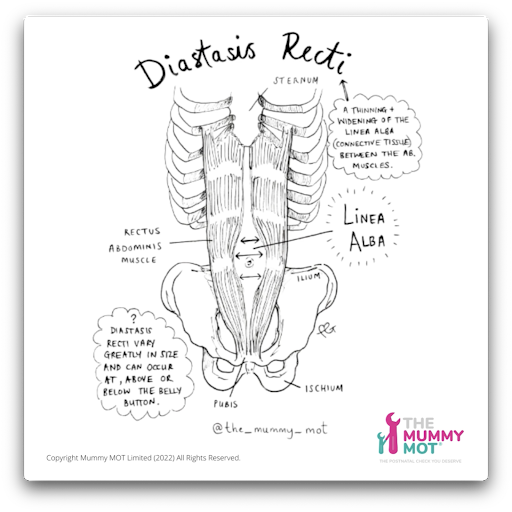
What is Diastasis Recti?
During pregnancy, the extraordinary journey of creating new life can bring about remarkable changes in a woman’s body. One such change is the diastasis recti, a separation of the rectus abdominis muscles along the midline of the abdomen. While it may sound concerning, it’s actually a very common occurrence, affecting nearly all women by the later stages of pregnancy.
This separation arises from the natural stretching of the linea alba, a connective tissue band. As the uterus expands to accommodate the growing baby, it exerts pressure on the linea alba, causing it to widen and thin. This widening, however, is crucial for providing the necessary space for the baby to develop comfortably.

Mummy MOT has more detailed information on their website. Click here to read more.
Empowering Recovery: Separating Fact from Fiction in Diastasis Recti
Myth 1: Diastasis recti means my abdominals are torn
When you hear “diastasis recti,” visions of ripped abs might flash through your mind. I say, there seems to be a bit of a misunderstanding about this. Let’s clear things up, shall we?
The Truth: Diastasis recti doesn’t involve torn muscles. Instead, it refers to a widening of the linea alba, the connective tissue band running down your abdomen. Think of it like a seam that stretches to accommodate a growing baby during pregnancy. While the linea alba may thin and widen, it remains intact, unlike a true muscle tear.
Myth 2: Diastasis Recti Always Leads to Complications
Many people who have diastasis recti do not experience pain. Diastasis recti does mean there has been a change to the structure of your abdominal wall. This is the result of decreased core strength as well as altered body mechanics. Our core muscles are a crucial component of support and stability, so it is possible that diastasis recti result in changes in our abilities to lift, run, jump or move how we used to before.

Myth 3: Only some women get diastasis recti during pregnancy
As mentioned, above, all pregnant people experience some form of diastasis recti during pregnancy. Think of diastasis recti like fingerprints - nobody’s quite the same! Genetics, baby size, body shape - they all influence how much our connective tissues stretch.
Myth 4: “Coning and doming” are signs that I should stop exercising
Diastasis recti manifests as outward “doming” or “coning” along the midline of the abdomen. Assessing the nature of this doming can provide valuable insights into the integrity of the linea alba and potential for further stretching.
Soft Doming: A Sign of Elasticity and Adaptability
Upon gentle palpation of the linea alba, a “soft doming” indicates that the tissue retains elasticity and readily gives way to pressure. This lack of resistance suggests that the linea alba has not reached its maximum tensile capacity and is unlikely to stretch further with appropriate management.
Hard Doming: A Potential Marker of Increased Tension
Conversely, a “hard doming” sensation, where the linea alba feels firm and taut under pressure, suggests that the connective tissue is under significant tension. This scenario raises concerns about possible further weakening and stretching of the linea alba if not addressed appropriately.

Most Frequently Asked Questions About Diastasis Recti
1. Can physiotherapy help fix diastasis recti?
The good news is, yes, physiotherapy can be a valuable tool in managing and potentially decreasing diastasis recti. Here’s how:
Posture, tummy and pelvic floor assessment: Tightness or weakness in the pelvic floor muscles can affect the rest of your core and contribute to diastasis recti symptoms. A pelvic health physiotherapist can assess your pelvic floor internally or externally and see how it works with your core system. Your physiotherapist will evaluate your alignment from head to toe, identifying any imbalances or faulty patterns that might be contributing to the diastasis recti. Based on this assessment, they can tailor your exercises and movement retraining to address any postural issues and promote optimal core activation.
Posture and breathing: Simple tweaks to your posture, sitting, movement, and breathing can significantly impact how your deep core works and how you manage intra-abdominal pressure, potentially reducing the separation.
Focus on strengthening: Research shows that exercises focusing on deep core stability can effectively narrow the gap between the rectus abdominis muscles and improve overall well-being, especially for postpartum women. A physiotherapist can design a personalised and progressive strengthening programme using a variety of exercises (including some with heavier weights) to find that “sweet spot” of challenge that aids natural healing.
2. How can I check for myself if I have tummy separation?
Your tummy gap will usually go back to normal by 8 to 12 weeks postpartum. If you would like to check the size of your separation at home you can do the following:
-
Lie on your back with your legs bent and your feet flat on the floor.
-
Raise your shoulders off the floor slightly and look down at your tummy.
-
Whilst using your fingertips, feel between the edge of your muscles. This is above and below the belly button.
-
From there you can see how many fingers you can fit into the gap between the two muscles.

3. Will my diastasis recti ever go away or how long will it take to heal?
Everyone’s different, so the time it takes to ‘heal’ or ‘recover’ from diastasis recti varies based on several factors, like the gap’s size, activity levels, lifestyle, hormone balance, body shape, genetics, and movement patterns. For many people, a significant reduction in the gap happens naturally within four to six weeks after the birth (postpartum).
If your diastasis is taking longer to improve even with physiotherapy, bear in mind that connective tissue mends slower than muscle. So, patience is key – it might take up to 18 months to see proper results.
4. What physio exercises are good for diastasis recti?
There is no one exercise that works for everyone. Progress takes time and consistency. A personalised program focusing on core, back, and glute strengthening in different positions and challenges can make a difference.
I hope this is helpful and explains the natural process we all go through to allow our babies to grow. As physios, we need to ensure we are spreading the right message.
Don’t hesitate to reach out if you have any questions or need guidance on safe and effective treatment.







